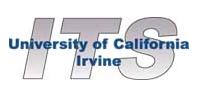

Transportation Management Using Cooperating Roadside
and In-vehicle Communication Devices
 |
 |
A Distributed On-line Database System for Transportation Management Using Cooperating Roadside and In-vehicle Communication Devices |
| Team | Abstract | Approach | Survey | Reports |
| PROJECT TEAM | [ back to top ] |
|
R. Jayakrishnan <rjayakri@uci.edu> Web:
http://www.eng.uci.edu/faculty_research/profile/rjayakri M. G. McNally <mmcnally@uci.edu> Web: http://www.its.uci.edu/~mmcnally/ James E. Marca <jmarca@translab.its.uci.edu> Craig R. Rindt <crindt@translab.its.uci.edu> Institute of Transportation Studies and Funded by a grant from the National Science Foundation. [NSF Summary] September 15, 2003 through March 15, 2005 | |
| PROJECT ABSTRACT | [ back to top ] |
|
This research tackles the problem of collecting, storing, and using an arbitrarily
complete trip table for each vehicle in an urban traffic network, which can be
trusted by transportation system operators while simultaneously ensuring traveler
privacy. To achieve this goal, each vehicle stores its own travel history, under
the consent of the driver, by accepting authenticated information from roadside
controllers-persistent traffic cookies-using short-range wireless communication.
The authenticated data stored in each vehicle forms a distributed database of
historical travel patterns. The central hypothesis of the project is that these
historical travel patterns can be used to predict the movement of vehicles currently
in the system, which can, in turn, be used for traffic management applications.
The project consists of three overlapping research tasks. The first examines the design and performance of the distributed travel database and prediction system using simulation experiments. This task will develop and use a new modeling framework that integrates a microscopic traffic model and a multi-agent, activity-based travel demand model. The second task explores how such predictions can be applied to improve the design, management, and operation of the transportation system. For instance, local traffic controllers can move beyond turning fractions, and instead predict whether and where a platoon will disperse as it moves through the traffic network. Local intersection control schemes can incorporate the global consequences of their control measures. Path flow predictions made by the system can also serve as a direct input to existing dynamic traffic assignment formulations. The third task administers a small survey of traveler attitudes on privacy and utility issues involved in such a system. The results will help ascertain the feasibility of the system and balance the functional requirements with stakeholder and end-user interests in security and privacy. The broader impacts of the research include the following:
| |
| RESEARCH APPROACH | [ back to top ] |
|
The proposed activity will be conducted in two phases. During the first phase, the simulation framework will be implemented including the basic features of the distributed travel demand database system. The second phase will involve experimental analysis of a set of applications that leverage the distributed database infrastructure.
Phase 1: Activity-based Traffic Operations Simulation System
Phase 2: Evaluation of Traffic Management Applications |
|
| DRIVER ATTITUDE SURVEY | [ back to top ] |
|
Drivers may feel uncomfortable, at least initially, with in-vehicle devices that
reveal data on their driving behavior and destinations. A driver attitude survey
is to be implemented where drivers are presented with one or two simple scenarios
where selected characteristics of their driving pattern would be recorded to then
provide a potential benefit to the driver (e.g., a faster travel time). The survey
will query regarding issues of general acceptance and acceptance with various
levels of driver benefit.
It is anticipated that a post card survey of a targeted population will be used. Tentatively, UCI faculty, staff, and students who drive to and park on campus will be selected. A twp part post card will be distributed to drivers entering selected parking lots and structures (or left on windshields). One part will explain the purpose of the survey and ensure respondent confidentiality (there will not be any personal information whatsoever on the postcard. The second part will contain a small number of questions and will be returned by mail (or other means such as drop boxes). When the final design is completed, the two part survey will be posted to this web site. | |
| REPORTS AND PAPERS | [ back to top ] |
|
Related ITS Research Projects:
Project Working Papers and Reports | |
| Last Updated: 01 October 2005 | [ back to top ] |
| Team | Abstract | Approach | Survey | Reports |
| [ PI Projects | ITS Projects | ITS Home Page | UCI ] |